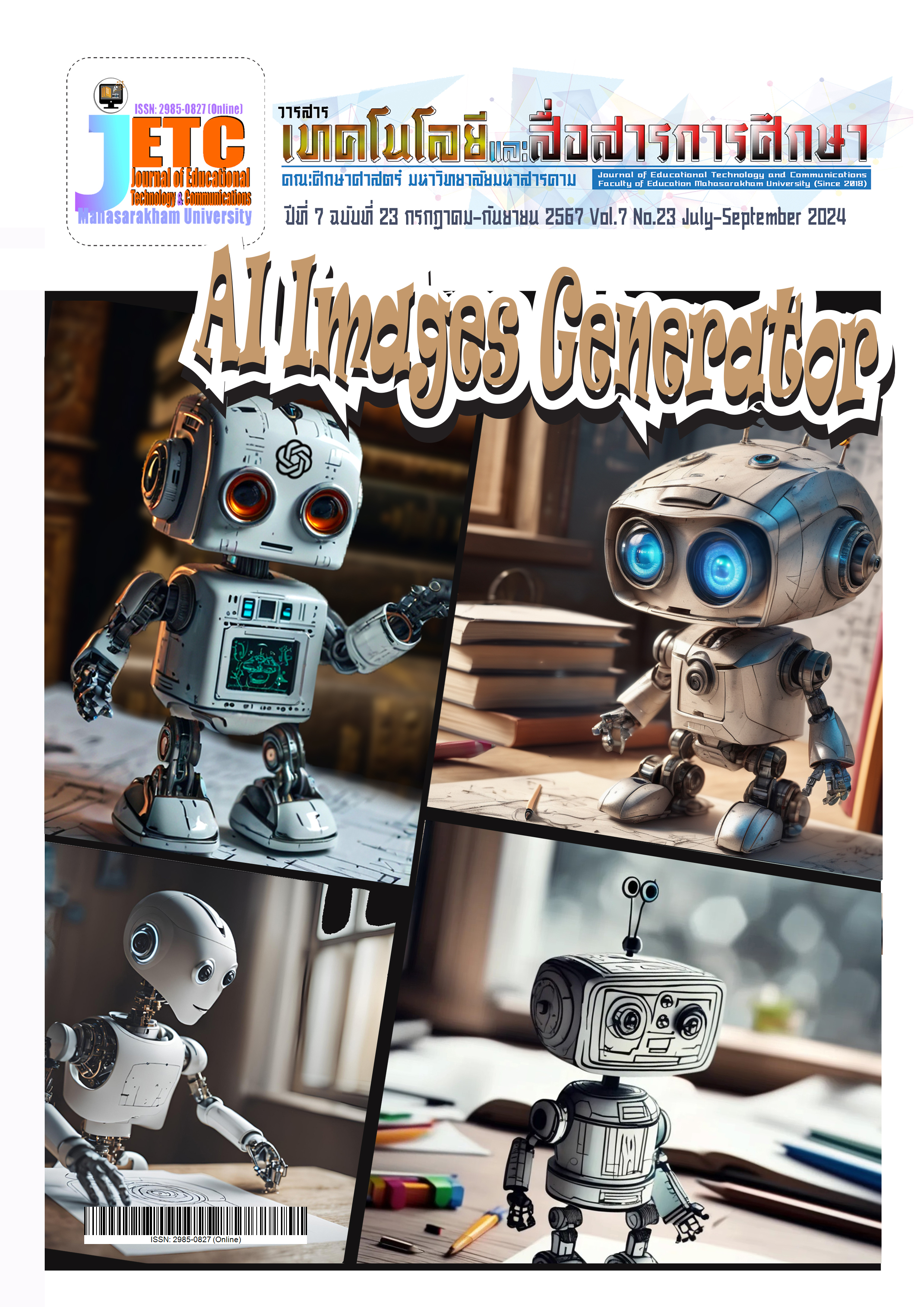The Development of Blended Learning Using Cooperative Learning with STAD Technique to Enhance Group Working Skills and Academic Achievement in Computing Science of Mathayomsuksa 3 Students
Main Article Content
Abstract
This research aimed to 1) develop and find the efficiency of blended learning management using cooperative learning with STAD techniques in computing science of Mathayomsuksa 3 students following the criteria of 80/80 2) find the effectiveness Index of academic achievement and group working skills 3) study the Mathayomsuksa 3 students’ satisfaction. The target group consisted of 30 students studying in Matthayomsuksa 3 at Ban Phu Lek School during the second semester in the academic year 2023. The instruments included 1) a blended learning management using cooperative learning with STAD techniques lesson plan 2) an achievement test 3) an evaluation of group working skills, and 4) a satisfaction questionnaire. The statistics used in the research were percentage, mean, standard deviation, and effectiveness index.
The research results were:
1) The blended learning management using cooperative learning with STAD techniques lesson plan that consisted of four steps cycle: teach, team study, test, and recognition received a high level of evaluation (µ=4.86, =0.022) and had standard criteria efficiency as 83.80/85.80.
2) The effectiveness of academic achievement as 0.6491, which showed that the students had higher academic achievement at 64.91% and the effectiveness Index of group working skills as 0.7322, which showed that the students gained more group working skills at 73.22%
3) The student satisfaction toward learning activities was at the highest level (µ=4.78, =0.45)
Downloads
Article Details
References
กมลวรรณ สีใส และคณะ. (2565). การพัฒนาแผนการจัดการเรียนรู้การสร้างสรรค์สื่อการเรียนรู้ สำหรับนักศึกษาวิชาชีพครูและครูสถาบันการอาชีวศึกษา สาขาคหกรรม. วารสารศึกษาศาสตร์ มหาวิทยาลัยบูรพา, 33(1). 57-71. https://so02.tci-thaijo.org/index.php/edubuu/article/view/256075
กุลธิดา ทุ่งคาใน. (2564). การเรียนรู้แบบผสมผสาน Blended Learning ในวิถี New Normal Blended Learning in a New Normal. ครุศาสตร์สาร มหาวิทยาลัยราชภัฏบ้านสมเด็จเจ้าพระยา, 15(1), 29-43.
จันทร์ ติยะวงศ์. (2564). ผลการเรียนรู้แบบร่วมมือเทคนิค STAD เรื่องการบวก ลบ คุณ หาร พหุนาม ที่มีต่อผลสัมฤทธิ์ทางการเรียนและความพึงพอใจ ของนักเรียนชั้นมัธยมศึกษาตอนต้น. วารสารวิชาการ มหาวิทยาลัยนอร์ทกรุงเทพ, 10(1). 34-45. https://so01.tci-thaijo.org/index.php/NBU/article/view/247588
จันทิมา ชุวานนท์. (2563). การใช้วิธีการเรียนแบบผสมผสานในรายวิชาวิธีการวิจัย สำหรับนักศึกษาสาขาภาษาอังกฤษธุรกิจมหาวิทยาลัยราชภัฏธนบุรี. [วิทยานิพนธ์ปริญญามหาบัณฑิต. มหาวิทยาลัยราชภัฎธนบุรี] . https://cms.dru.ac.th/jspui/handle/123456789/1678
ทิศนา แขมมณี. (2559). ศาสตร์การสอน : องค์ความรู้เพื่อการจัดกระบวนการเรียนรู้ที่มีประสิทธิภาพ (พิมพ์ครั้งที่ 20). สำนักพิมพ์แห่งจุฬาลงกรณ์มหาวิทยาลัย.
บุญชม ศรีสะอาด. (2560). การวิจัยสำหรับครู (พิมพ์ครั้งที่ 3). สำนักพิมพ์สุวีรยาสาส์น.
ปรัชญนันท์ นิลสุข และปณิตา วรรณพิรุณ. (2556). การจัดการเรียนรู้แบบผสมผสาน: สัดส่วนการผสมผสาน. วารสารพัฒนาเทคนิคศึกษา. 25(85). 31-36.
ปิยะวรรณ สายสุทธิ และ ปถมาภรณ์ ไทยโพธิ์ศรี. (2565). การพัฒนาบทเรียนอีเลิร์นนิง รายวิชา วิทยาการคำนวณร่วมกับการใช้เทคนิค STAD สำหรับนักเรียนชั้นปีที่ 2 โรงเรียนสระกะเทียมวิทยาคม. การประชุมวิชาการระดับชาติ ครั้งที่ 14 . มหาวิทยาลัยราชภัฎนครปฐม.
ศิริรัตน์ หวังสะแล่ะฮ์. (2564). แนวทางการจัดการเรียนการสอนสาระวิทยาการคำนวณ ระดับมัธยมศึกษาตอนต้น. วารสารสมาคมนักวิจัย, 26(1), 116-132. https://so04.tci-thaijo.org/index.php/jar/article/view/247399
ศิริวรรณ ศิริสุขประเสริฐ. (2562). การพัฒนาผลการเรียนรู้และทักษะการทำงานกลุ่ม เรื่อง การแบ่งเซลล์ โดยใช้การจัดการเรียนรู้แบบร่วมมือด้วยเทคนิค STAD ร่วมกับเทคนิคแผนผังความคิด ของนักเรียนชั้นมัธยมศึกษาปีที่ 4. วิทยานิพนธ์ปริญญามหาบัณฑิต,วิทยาลัยครูสุริยเทพ]. https://rsuir-library.rsu.ac.th/handle/123456789/106
สถาบันส่งเสริมการสอนวิทยาศาสตร์และเทคโนโลยี (สสวท.). (2562). การจัดสาระการเรียนรู้กลุ่ม วิทยาศาสตร์ หลักสูตรการศึกษาขั้นพื้นฐาน. สถาบันส่งเสริมการสอนวิทยาศาสตร์และเทคโนโลยี.
สุนารี นวลจันทร์. (2562). ผลสัมฤทธิ์ทางการเรียนวิชาคณิตศาสตร์และความสามารถในการทำงานกลุ่ม เรื่อง ระบบจำนวนจริง โดยการเรียนแบบร่วมมือเทคนิค STAD ร่วมกับเกมคณิตศาสตร์ ของนักเรียนชั้นมัธยมศึกษาปีที่ 4. วิทยานิพนธ์ปริญญามหาบัณฑิต ไม่ได้ตีพิมพ์]. มหาวิทยาลัยทักษิณ.
สุนิสา ทรัพย์สูงเนิน, ดุสิต ขาวเหลือง และสิราวรรณ จรัสรวีวัฒน์. (2563). ผลการจัดกิจกรรมการเรียนรู้โดยใช้รูปแบบการเรียนรู้แบบกลุ่มร่วมมือเทคนิค STAD สำหรับนักศึกษาระดับประกาศนียบัตรวิชาชีพชั้นสูง ปีที่ 1 สาขาการบัญชี. วารสาร BUUIR คลังปัญญามหาวิทยาลัยบูรพา, 2(2). 44-59. https://so01.tci-thaijo.org/index.php/ejes/article/view/242109
อธิษฐ์ เชิญขวัญชัย และธนดล ภูสีฤทธิ์. (2563). การพัฒนาการจัดกิจกรรมการเรียนรู้แบบร่วมมือด้วยเทคนิค STAD ประกอบหนังสือประยุกต์ใช้เทคโนโลยีความเป็นจริงเสริม (Augmented Reality) เรื่อง การเจริญเติบโตและพัฒนาการของมนุษย์ สำหรับนักเรียนชั้นประถมศึกษาปีที่ 6. วารสารเทคโนโลยีและสื่อสารการศึกษา คณะศึกษาศาสตร์ มหาวิทยาลัยมหาสารคาม. 3(9), 74-85. https://so02.tci-thaijo.org/index.php/etcedumsujournal/article/view/242540
Oh, K. & Lee, S.-H. (2021). Application of Home Economics Teaching-Learning Plan in the Clothing For Teenager’s mpowerment. Journal of Korean Home Economics Education Association. 33 (1), 169-184. http://doi.org/10.19031/jkheea.2021.3.33.1.169
Parker, G. M. (1990). Team Players and Team Work : The New Competitive Business Strategy. Jossey-Bass.
Utami,I.S. (2018). The effect of blended learning model on senior high school students’ Achievement. In SHS Web of Conference , 42(2018), 6. https://doi.org/10.1051/shsconf/20184200027

